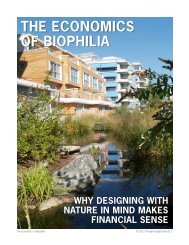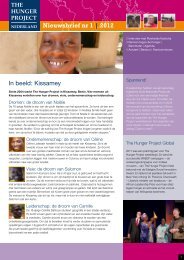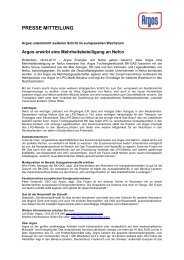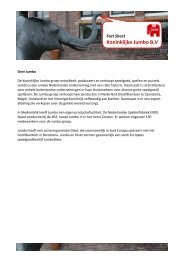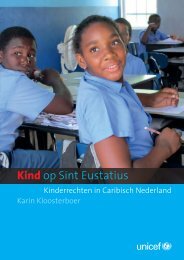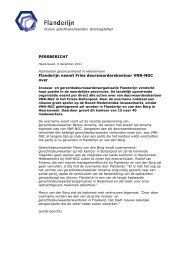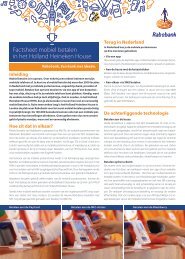The Situation of Children and Adolescents in Aruba: - Pers - Unicef
The Situation of Children and Adolescents in Aruba: - Pers - Unicef
The Situation of Children and Adolescents in Aruba: - Pers - Unicef
Create successful ePaper yourself
Turn your PDF publications into a flip-book with our unique Google optimized e-Paper software.
<strong>The</strong> <strong>Situation</strong> <strong>of</strong> <strong>Children</strong> <strong>and</strong><br />
<strong>Adolescents</strong> <strong>in</strong> <strong>Aruba</strong>:<br />
Key f<strong>in</strong>d<strong>in</strong>gs <strong>and</strong> recommendations
© United Nations <strong>Children</strong>’s Fund (UNICEF), 2013<br />
Cover/back cover photo credits © UNICEF/UNI119868/LeMoyne<br />
Disclaimer:<br />
<strong>The</strong> statements <strong>in</strong> this publication are the views <strong>of</strong> the author <strong>and</strong> do not necessarily reflect the policies<br />
or the views <strong>of</strong> UNICEF.<br />
<strong>The</strong> designations employed <strong>in</strong> this publication <strong>and</strong> the presentation <strong>of</strong> the material do not imply on the<br />
part <strong>of</strong> the United Nations <strong>Children</strong>’s Fund (UNICEF) the expression <strong>of</strong> any op<strong>in</strong>ion whatsoever concern<strong>in</strong>g<br />
the legal status <strong>of</strong> any country or territory, or <strong>of</strong> its authorities or the delimitations <strong>of</strong> its frontiers.<br />
Design <strong>and</strong> layout: Shiloh Productions
Introduction<br />
Photo: UNICEF/NYHQ20111854/LeMoyne<br />
A situation analysis <strong>of</strong> children, adolescents <strong>and</strong> women <strong>in</strong> <strong>Aruba</strong> was undertaken <strong>in</strong> 2011–2012. Commissioned<br />
by the United Nations <strong>Children</strong>’s Fund-<strong>The</strong> Americas <strong>and</strong> Caribbean Regional Office , it was conducted by the<br />
Observatorio Social del Ecuador (OSE), a non-governmental organization based <strong>in</strong> Quito. <strong>The</strong> study had two ma<strong>in</strong><br />
objectives: to evaluate progress <strong>and</strong> challenges around the implementation <strong>of</strong> the rights <strong>of</strong> children <strong>and</strong> women;<br />
<strong>and</strong> to make recommendations for social action <strong>and</strong> public policies <strong>in</strong> the medium <strong>and</strong> long term <strong>in</strong> order to<br />
improve the conditions <strong>and</strong> life opportunities <strong>of</strong> those population groups.<br />
3
<strong>The</strong> <strong>Situation</strong> <strong>of</strong> <strong>Children</strong> <strong>and</strong> <strong>Adolescents</strong> <strong>in</strong> aruba:<br />
Key f<strong>in</strong>d<strong>in</strong>gs <strong>and</strong> recommendations<br />
<strong>The</strong> research methodology used a highly participatory approach, <strong>in</strong>clud<strong>in</strong>g <strong>in</strong>-depth <strong>in</strong>terviews with 50 key<br />
<strong>in</strong>formants from the state, civil society, academia <strong>and</strong> <strong>in</strong>ternational organizations, comb<strong>in</strong>ed with statistical analysis<br />
based on <strong>in</strong>formation from the 2001 <strong>and</strong> 2010 censuses complemented by data from other sources.<br />
S<strong>in</strong>ce 1986 <strong>Aruba</strong> has been an autonomous country with<strong>in</strong> the K<strong>in</strong>gdom <strong>of</strong> the Netherl<strong>and</strong>s; however, four<br />
centuries <strong>of</strong> colonialism have cont<strong>in</strong>u<strong>in</strong>g effects <strong>in</strong>clud<strong>in</strong>g a legal framework based on the Dutch Constitution<br />
<strong>and</strong> a Dutch model <strong>of</strong> education. <strong>The</strong> Netherl<strong>and</strong>s rema<strong>in</strong>s responsible for the isl<strong>and</strong>’s <strong>in</strong>ternational relations,<br />
<strong>in</strong>clud<strong>in</strong>g report<strong>in</strong>g to <strong>in</strong>ternational human rights bodies such as the CRC, <strong>and</strong> national security. As part <strong>of</strong> the<br />
K<strong>in</strong>gdom, <strong>Aruba</strong> has assumed commitments to a number <strong>of</strong> <strong>in</strong>ternational treaties <strong>and</strong> agreements <strong>in</strong>clud<strong>in</strong>g the<br />
Convention on the Rights <strong>of</strong> the Child (CRC) <strong>and</strong> the Convention on the Elim<strong>in</strong>ation <strong>of</strong> All Forms <strong>of</strong> Discrim<strong>in</strong>ation<br />
aga<strong>in</strong>st Women (CEDAW) <strong>and</strong> therefore has been prepar<strong>in</strong>g <strong>in</strong>puts from <strong>Aruba</strong> to the reports <strong>of</strong> the K<strong>in</strong>gdom to<br />
the CRC <strong>and</strong> the CEDAW committees which periodically review implementation <strong>of</strong> recommendations <strong>and</strong> measure<br />
progress.<br />
<strong>The</strong> isl<strong>and</strong>’s development has also been strongly <strong>in</strong>fluenced by a long history <strong>of</strong> migration <strong>and</strong> immigration. Most<br />
recently immigrants have come to fill the multiple employment opportunities <strong>in</strong> construction <strong>and</strong> services <strong>of</strong>fered<br />
by tourism, which is now the ma<strong>in</strong> driver <strong>of</strong> economic growth. <strong>The</strong> 2010 Population <strong>and</strong> Hous<strong>in</strong>g Census <strong>in</strong>dicates<br />
that 34 per cent <strong>of</strong> the population were foreign born, mak<strong>in</strong>g the isl<strong>and</strong> both multicultural <strong>and</strong> multil<strong>in</strong>gual. Of the<br />
107,557 residents, 25 per cent are children <strong>and</strong> adolescents <strong>and</strong> 53 per cent are women.<br />
<strong>Aruba</strong> has high performance <strong>in</strong>dicators, comparable to developed countries, <strong>and</strong> the population’s st<strong>and</strong>ard <strong>of</strong><br />
liv<strong>in</strong>g is generally good: 100 per cent <strong>of</strong> residents, <strong>in</strong>clud<strong>in</strong>g documented immigrants, have social security <strong>and</strong><br />
health <strong>in</strong>surance; primary <strong>and</strong> secondary education are free; 97 per cent <strong>of</strong> the population 15 years <strong>and</strong> older are<br />
literate; <strong>and</strong> there is a pension programme that guarantees a m<strong>in</strong>imum <strong>in</strong>come for older adults. This progress is<br />
due <strong>in</strong> large part to the way the state distributes the national budget, prioritiz<strong>in</strong>g social <strong>in</strong>vestment. From 1999<br />
to 2009, spend<strong>in</strong>g on the health sector, on average, accounted for 8 per cent <strong>of</strong> total gross domestic product,<br />
education 6.7 per cent <strong>and</strong> social protection 7.4 per cent.<br />
<strong>The</strong> M<strong>in</strong>istry <strong>of</strong> Economic Affairs, Social Affairs <strong>and</strong> Culture established the follow<strong>in</strong>g priorities for the period<br />
2009–2013: development <strong>of</strong> children <strong>and</strong> adolescents; development <strong>of</strong> women; welfare <strong>of</strong> the economically<br />
disadvantaged population; special needs; care <strong>of</strong> the elderly; <strong>and</strong> production <strong>and</strong> analysis <strong>of</strong> data <strong>in</strong> the social<br />
affairs field. One important action has been the <strong>in</strong>troduction a payment to help support s<strong>in</strong>gle mothers. <strong>The</strong><br />
Government has also established a committee aga<strong>in</strong>st child abuse <strong>and</strong> organized the first national conference on<br />
child abuse.<br />
4
Key f<strong>in</strong>d<strong>in</strong>gs<br />
Photo: © UNICEF/UNI119848/LeMoyne<br />
Research f<strong>in</strong>d<strong>in</strong>gs show that <strong>Aruba</strong> has fulfilled many <strong>of</strong> the goals def<strong>in</strong>ed <strong>in</strong> <strong>in</strong>ternational agreements <strong>and</strong>, <strong>in</strong><br />
general terms, the rights <strong>of</strong> children <strong>and</strong> women are met <strong>in</strong> an adequate manner. At the same time, however,<br />
several limitations to progress <strong>in</strong> the lives <strong>of</strong> children <strong>and</strong> women have only recently been placed on the public<br />
agenda. <strong>The</strong>se limitations have structural causes l<strong>in</strong>ked to economic pressures that have led more <strong>and</strong> more<br />
<strong>Aruba</strong>ns to take multiple jobs to meet their basic needs <strong>and</strong> have had a detrimental effect on social relations,<br />
especially with<strong>in</strong> households. This <strong>in</strong> turn has led to the reconfiguration <strong>of</strong> traditional roles <strong>and</strong>, <strong>in</strong> many cases,<br />
deterioration <strong>in</strong> the quality <strong>of</strong> care or neglect <strong>of</strong> children.<br />
5
<strong>The</strong> <strong>Situation</strong> <strong>of</strong> <strong>Children</strong> <strong>and</strong> <strong>Adolescents</strong> <strong>in</strong> aruba:<br />
Key f<strong>in</strong>d<strong>in</strong>gs <strong>and</strong> recommendations<br />
<strong>The</strong> right to health<br />
Progress achieved<br />
Overall, the health system is well organized, with adequate attention to the provision <strong>of</strong> health services for<br />
children <strong>and</strong> adolescents. A Department <strong>of</strong> Child <strong>and</strong> Youth Health provides good quality services <strong>and</strong> ensures the<br />
availability <strong>of</strong> adequate child health data. <strong>The</strong> health <strong>of</strong> children attend<strong>in</strong>g preschools <strong>and</strong> schools is monitored,<br />
<strong>in</strong>clud<strong>in</strong>g assessments <strong>of</strong> levels <strong>of</strong> obesity. In addition, the Department has started psychosocial health-care<br />
services aimed at promot<strong>in</strong>g the sound socio-emotional development <strong>of</strong> all children <strong>in</strong> schools.<br />
<strong>The</strong> <strong>in</strong>fant mortality rate (under 1 year) was reduced by 75 per cent between 2000 <strong>and</strong> 2006 – from 6.2 to 1.6 per<br />
1,000 live births. <strong>The</strong>re is also a cont<strong>in</strong>u<strong>in</strong>g low rate <strong>of</strong> child mortality (under 5 years). Antenatal care covers 99.2<br />
per cent <strong>of</strong> women <strong>and</strong> 95.8 per cent have <strong>in</strong>stitutional deliveries. All children, <strong>in</strong>clud<strong>in</strong>g immigrants, have access<br />
to health <strong>in</strong>surance <strong>and</strong> 9 out <strong>of</strong> 10 children between 12 <strong>and</strong> 23 months are vacc<strong>in</strong>ated before their first birthday.<br />
<strong>The</strong>re is universal access to safe water <strong>and</strong> basic sanitation.<br />
<strong>Aruba</strong> registers only 435 cases <strong>of</strong> HIV <strong>and</strong> AIDS <strong>of</strong> which very few are children. Mother-to-child transmission is very<br />
low (2 per cent), <strong>and</strong> these children are treated immediately after birth with antiretroviral therapy.<br />
Challenges rema<strong>in</strong><strong>in</strong>g<br />
Obesity is the ma<strong>in</strong> public health problem affect<strong>in</strong>g children <strong>and</strong> adolescents (35 per cent <strong>of</strong> this group are<br />
overweight), lead<strong>in</strong>g to other diseases such as diabetes <strong>and</strong> hypertension. Some <strong>of</strong> the reasons for this <strong>in</strong>clude the<br />
limited local production <strong>of</strong> fruits <strong>and</strong> vegetables <strong>and</strong> the high costs <strong>of</strong> imports, which encourages the consumption<br />
<strong>of</strong> cheaper, high-calorie foods; the lack <strong>of</strong> regular <strong>in</strong>volvement <strong>in</strong> physical activity by over three quarters <strong>of</strong> children<br />
aged between 6 <strong>and</strong> 11; <strong>and</strong> the low percentage <strong>of</strong> <strong>in</strong>fants who are exclusively breastfed.<br />
Teen pregnancy is also a phenomenon that requires cont<strong>in</strong>ued attention, with adolescent girls account<strong>in</strong>g for just<br />
over 1 <strong>in</strong> 10 births. This limits their ability to achieve their goals <strong>and</strong> may put them at risk <strong>of</strong> ongo<strong>in</strong>g poverty.<br />
<strong>The</strong>re is limited dialogue between parents <strong>and</strong> children about sex <strong>and</strong> pregnancy prevention <strong>and</strong> a limited sexual<br />
education programmes <strong>in</strong> schools.<br />
<strong>The</strong> right to education<br />
Progress achieved<br />
A law mak<strong>in</strong>g education compulsory was passed by Parliament <strong>in</strong> 2011, <strong>and</strong> school<strong>in</strong>g is free apart from a m<strong>in</strong>imal<br />
yearly contribution plus the costs <strong>of</strong> supplies <strong>and</strong> uniforms. <strong>The</strong>re was already universal primary education,<br />
progress towards the elim<strong>in</strong>ation <strong>of</strong> gender differences <strong>and</strong> more women than men <strong>in</strong> high school <strong>and</strong> college.<br />
<strong>The</strong> Government is also develop<strong>in</strong>g a new educational curriculum that aims to <strong>in</strong>troduce Papiamento <strong>in</strong>to teach<strong>in</strong>g<br />
(see challenges below).<br />
6
Key f<strong>in</strong>d<strong>in</strong>gs<br />
S<strong>in</strong>ce 2007, the M<strong>in</strong>istry <strong>of</strong> Justice <strong>and</strong> Education has carried out a national education plan that aims to improve<br />
educational level on several fronts. <strong>The</strong>re is a clear system for supervis<strong>in</strong>g the quality <strong>of</strong> schools, with both <strong>in</strong>ternal<br />
mechanisms for quality control <strong>and</strong> external evaluations by the school <strong>in</strong>spection unit from the M<strong>in</strong>istry. Other<br />
recent government measures are the PRISMA project (which helps non-Dutch-speak<strong>in</strong>g students familiarize<br />
themselves with the Dutch language); the Traimerdia project (<strong>of</strong>fer<strong>in</strong>g after-school supervision <strong>of</strong> children <strong>in</strong><br />
preschool <strong>and</strong> primary school); <strong>and</strong> the provision <strong>of</strong> some after-school programmes for adolescents.<br />
Challenges rema<strong>in</strong><strong>in</strong>g<br />
One <strong>of</strong> the major educational problems is the persistence <strong>of</strong> a Dutch educational model that is not adapted to local<br />
needs: only 6 per cent <strong>of</strong> the population speak Dutch at home while 68 per cent speak Papiamento, 14 per cent<br />
speak Spanish <strong>and</strong> 7 per cent speak English. This is one <strong>of</strong> the causes <strong>of</strong> the high dropout rate, especially among<br />
males. <strong>The</strong>re is also a lot <strong>of</strong> repetition, with children not study<strong>in</strong>g <strong>in</strong> grades correspond<strong>in</strong>g to their age. <strong>The</strong>re is no<br />
mechanism to re<strong>in</strong>tegrate those who drop out or are expelled, <strong>and</strong> children may become NEETs (not <strong>in</strong> education,<br />
employment or tra<strong>in</strong><strong>in</strong>g), get <strong>in</strong>volved <strong>in</strong> gangs <strong>and</strong> engage <strong>in</strong> illegal forms <strong>of</strong> subsistence.<br />
Another problem is the absence <strong>of</strong> communication channels between parents <strong>and</strong> schools. This is compounded by<br />
the fact that parents delegate all responsibility for their children’s development to the teachers. Also, there are few<br />
quality after-school childcare alternatives for children or adolescents. Day-care centres are <strong>of</strong>ten <strong>of</strong> poor quality,<br />
that may lead to neglect <strong>and</strong> even abuse. Hav<strong>in</strong>g <strong>in</strong>sufficient numbers <strong>of</strong> teachers <strong>and</strong> schools limits the possibility<br />
<strong>of</strong> special needs education, as does the small amount <strong>of</strong> f<strong>in</strong>ancial assistance available.<br />
<strong>The</strong>re is little diversity <strong>in</strong> the options <strong>of</strong>fered at university level, <strong>and</strong> there are also limited career opportunities.<br />
A significant number <strong>of</strong> students cont<strong>in</strong>ue their studies abroad, ma<strong>in</strong>ly <strong>in</strong> the Netherl<strong>and</strong>s, <strong>and</strong> social policies to<br />
promote their return when qualified are lack<strong>in</strong>g.<br />
<strong>The</strong> right to protection<br />
Progress achieved<br />
Bureau Sostenemi is the core <strong>of</strong> an <strong>in</strong>itial protection system for children <strong>and</strong> adolescents. Its ma<strong>in</strong> task is to redirect<br />
cases <strong>of</strong> neglect, abuse <strong>and</strong>/or violence aga<strong>in</strong>st children to other state agencies that can provide adequate follow<br />
up. <strong>The</strong>re are also about 50 civil society organizations work<strong>in</strong>g on issues that affect children <strong>and</strong> adolescents,<br />
<strong>in</strong>clud<strong>in</strong>g a Youth Telephone L<strong>in</strong>e that <strong>of</strong>fers assistance <strong>and</strong> access to protective services to children <strong>and</strong> adolescents<br />
through a toll-free phone <strong>and</strong> via chat.<br />
<strong>The</strong> new crim<strong>in</strong>al code adopted <strong>in</strong> 2012 established a juvenile justice system that provides the court with a<br />
wider range <strong>of</strong> sanctions, <strong>in</strong>clud<strong>in</strong>g placement <strong>in</strong> a juvenile detention centre <strong>and</strong> tra<strong>in</strong><strong>in</strong>g orders. However, its<br />
implementation will require specialized judge(s) for juvenile cases, separation <strong>of</strong> children from adult convicts<br />
when sentenced, CRC-tra<strong>in</strong><strong>in</strong>g for all <strong>in</strong>volved <strong>in</strong> deal<strong>in</strong>g with young <strong>of</strong>fenders <strong>and</strong> the <strong>in</strong>tensification <strong>of</strong> measures<br />
to prevent children from gett<strong>in</strong>g <strong>in</strong>to conflict with the law <strong>in</strong> the first place.<br />
7
<strong>The</strong> <strong>Situation</strong> <strong>of</strong> <strong>Children</strong> <strong>and</strong> <strong>Adolescents</strong> <strong>in</strong> aruba:<br />
Key f<strong>in</strong>d<strong>in</strong>gs <strong>and</strong> recommendations<br />
Challenges rema<strong>in</strong><strong>in</strong>g<br />
Although the establishment <strong>of</strong> the Sostenemi Bureau is a crucial first step, there is still not a comprehensive system<br />
<strong>of</strong> care <strong>and</strong> protection for children <strong>and</strong> adolescents. Moreover, the civil society organizations that seek to reduce<br />
family violence work <strong>in</strong>dependently <strong>and</strong> do not have a common agenda.<br />
Domestic violence <strong>in</strong> the home affects children, adolescents <strong>and</strong> women. Accord<strong>in</strong>g to reports from the Youth<br />
Telephone L<strong>in</strong>e, about 1 <strong>of</strong> every 10 calls made by children <strong>in</strong> the last three years were related to violence. Parents<br />
<strong>of</strong>ten lack authority <strong>and</strong> may resort to violence as a form <strong>of</strong> discipl<strong>in</strong>e. Due to the long hours worked by parents,<br />
more <strong>and</strong> more children <strong>and</strong> adolescents grow up alone, many times <strong>in</strong> unfavourable environments. <strong>The</strong> cases<br />
Bureau Sostenemi saw between 2007 <strong>and</strong> 2010 were physical, mental <strong>and</strong> emotional neglect, sexual abuse <strong>and</strong><br />
domestic violence. While sexual abuse is punishable by law, but difficult to prove, punishment is not strict <strong>and</strong> the<br />
maximum penalty <strong>of</strong> 8 years is not applied.<br />
While there are no reports <strong>of</strong> child sex tourism, the phenomenon <strong>of</strong> ‘sugar daddies’ exists, where girls go out with<br />
much older men <strong>in</strong> the expectation <strong>of</strong> receiv<strong>in</strong>g material goods.<br />
<strong>The</strong> right to participation<br />
Progress achieved<br />
Among the civil society organizations focused on women <strong>and</strong> children, n<strong>in</strong>e work with <strong>and</strong> for adolescents to<br />
promote youth participation <strong>and</strong> the fulfilment <strong>of</strong> their rights. Among these it is especially important to mention<br />
the Youth Parliament, which aims to ensure that the voices <strong>of</strong> young people are heard, valued <strong>and</strong> taken <strong>in</strong>to<br />
account <strong>in</strong> policy decisions that affect their lives.<br />
Challenges rema<strong>in</strong><strong>in</strong>g<br />
In general terms, the participation <strong>of</strong> adolescents <strong>in</strong> the public sphere is <strong>in</strong> an <strong>in</strong>itial phase, with a lack <strong>of</strong> spaces<br />
where young people can be heard. Furthermore, women lack equal rights <strong>and</strong> opportunities <strong>in</strong> the public sphere.<br />
In the past 10 years, there has been an <strong>in</strong>crease <strong>of</strong> only 2 seats for women <strong>in</strong> Parliament (from 19 men <strong>and</strong> 2<br />
women to 17 men <strong>and</strong> 4 women), re<strong>in</strong>forc<strong>in</strong>g the idea <strong>of</strong> the public space as one for men. Women still cannot<br />
access certa<strong>in</strong> occupational niches <strong>and</strong> they do not always work on equal terms, earn<strong>in</strong>g 10 per cent less than men.<br />
Although 1 <strong>in</strong> 10 children <strong>and</strong> adolescents is foreign born, the situation <strong>of</strong> immigrant children has been <strong>in</strong>visible.<br />
Immigrants are <strong>of</strong>ten socially excluded.<br />
8
Recommendations<br />
Recommendations<br />
General<br />
→→<br />
Implement <strong>in</strong>ternational agreements to which the isl<strong>and</strong> is committed by broaden<strong>in</strong>g knowledge <strong>of</strong><br />
the actions required, tak<strong>in</strong>g measures to reverse the legal constra<strong>in</strong>ts identified <strong>and</strong> design<strong>in</strong>g <strong>and</strong><br />
implement<strong>in</strong>g comprehensive policies to ensure compliance.<br />
→→<br />
→→<br />
→→<br />
Develop a consistent state policy to respond to the needs <strong>of</strong> children <strong>and</strong> adolescents with three key<br />
elements: an efficient <strong>in</strong>tegrated system <strong>of</strong> comprehensive care <strong>and</strong> protection; a specific code that<br />
def<strong>in</strong>es one state authority to formulate government policy <strong>and</strong> another to provide assistance; <strong>and</strong> the<br />
system <strong>of</strong> juvenile justice.<br />
Create processes <strong>of</strong> dialogue <strong>and</strong> jo<strong>in</strong>t efforts among the state, civil society organizations, the private<br />
sector <strong>and</strong> trade unions to reverse the exist<strong>in</strong>g <strong>in</strong>stitutional isolation <strong>and</strong> suggest real solutions to<br />
social problems.<br />
Cont<strong>in</strong>ue to deepen knowledge <strong>of</strong> the situation <strong>of</strong> children, adolescents <strong>and</strong> women through ongo<strong>in</strong>g<br />
monitor<strong>in</strong>g by the M<strong>in</strong>istry <strong>of</strong> Economic Affairs, Social Affairs <strong>and</strong> Culture <strong>in</strong> coord<strong>in</strong>ation with the<br />
University <strong>of</strong> <strong>Aruba</strong>.<br />
→→<br />
Health<br />
→→<br />
Promote regional <strong>in</strong>tegration with other countries <strong>in</strong> the Caribbean <strong>and</strong> the Americas to support a<br />
different model <strong>of</strong> economic development <strong>and</strong> contribute to the process <strong>of</strong> build<strong>in</strong>g an <strong>in</strong>dependent<br />
state.<br />
Create a programme for prevent<strong>in</strong>g <strong>and</strong> controll<strong>in</strong>g child obesity with <strong>in</strong>tegral <strong>in</strong>dicators <strong>and</strong> goals<br />
(<strong>in</strong>volv<strong>in</strong>g all the relevant m<strong>in</strong>istries).<br />
→→<br />
Create a nationwide campaign to promote breastfeed<strong>in</strong>g.<br />
→→<br />
Education<br />
→→<br />
Cont<strong>in</strong>ue implementation <strong>of</strong> programmes <strong>of</strong> sex education for the prevention <strong>of</strong> teenage pregnancy.<br />
Change the current Dutch-dependent educational model <strong>and</strong> develop <strong>and</strong> implement a new curriculum<br />
to meet the needs <strong>of</strong> a cultural diverse society.<br />
→→<br />
→→<br />
→→<br />
→→<br />
Re<strong>in</strong>force education quality control systems.<br />
Address the issue <strong>of</strong> children lagg<strong>in</strong>g beh<strong>in</strong>d <strong>and</strong> ensure the retention <strong>of</strong> children <strong>and</strong> adolescents <strong>in</strong><br />
the system.<br />
Tra<strong>in</strong> teachers <strong>and</strong> develop educational strategies to <strong>in</strong>tegrate special needs children <strong>in</strong>to regular<br />
schools.<br />
Provide after-school educational spaces <strong>and</strong> recreational opportunities for adolescents.<br />
9
<strong>The</strong> <strong>Situation</strong> <strong>of</strong> <strong>Children</strong> <strong>and</strong> <strong>Adolescents</strong> <strong>in</strong> aruba:<br />
Key f<strong>in</strong>d<strong>in</strong>gs <strong>and</strong> recommendations<br />
→→<br />
Offer educational rehabilitation programmes for children <strong>and</strong> adolescents who drop out <strong>of</strong> or are<br />
expelled from school.<br />
→→<br />
Guarantee that the day-care quality control system is be<strong>in</strong>g applied to correct identified deficiencies.<br />
Protection<br />
→→<br />
Promote <strong>and</strong> strengthen the role played by the Bureau Sostenemi <strong>in</strong> the implementation <strong>of</strong> child<br />
protection efforts.<br />
→→<br />
→→<br />
→→<br />
→→<br />
Further develop <strong>and</strong> strengthen the juvenile justice system, <strong>in</strong>clud<strong>in</strong>g through the use <strong>of</strong> specialized<br />
judges <strong>and</strong> appropriate mechanisms for deal<strong>in</strong>g with juvenile <strong>of</strong>fenders <strong>in</strong> accordance with the CRC.<br />
Put <strong>in</strong> place measures to prevent children from gett<strong>in</strong>g <strong>in</strong>volved <strong>in</strong> activities that are <strong>in</strong> conflict with<br />
the law.<br />
Make the problem <strong>of</strong> violence visible (through coord<strong>in</strong>ation between civil society, the state <strong>and</strong> the<br />
media) to prevent its normalization.<br />
Implement a programme <strong>of</strong> mental health care for children, adolescents <strong>and</strong> women who have been<br />
victims <strong>of</strong> violence.<br />
→→<br />
Develop jo<strong>in</strong>t social <strong>and</strong> economic policies regard<strong>in</strong>g the employment <strong>of</strong> women <strong>and</strong> provide mothers<br />
with childcare support, especially <strong>in</strong> the early years. This should <strong>in</strong>clude <strong>in</strong>volv<strong>in</strong>g fathers as caregivers.<br />
Participation<br />
→ → • Create mechanisms for strengthen<strong>in</strong>g youth participation at school – for example, through the<br />
formation <strong>of</strong> student councils – <strong>and</strong> <strong>in</strong> public spaces.<br />
→ → • Develop a gender policy to reverse the disadvantages that still persist between women <strong>and</strong> men<br />
<strong>in</strong> the areas <strong>of</strong> labour <strong>and</strong> political participation.<br />
→ → • Create mechanisms to make visible the situation <strong>of</strong> foreign-born residents, <strong>in</strong>clud<strong>in</strong>g undocumented<br />
women <strong>and</strong> children, <strong>in</strong>clud<strong>in</strong>g through qualitative <strong>and</strong> quantitative research.<br />
10
Conclusion<br />
Photo: © UNICEF/UNI119842/LeMoyne<br />
<strong>Aruba</strong> has huge potential <strong>and</strong> has already demonstrated significant progress <strong>in</strong> fulfill<strong>in</strong>g the rights found <strong>in</strong> the CRC<br />
<strong>and</strong> CEDAW. Now it needs to take the political <strong>and</strong> social decision to resolutely tackle the challenges encountered<br />
to ensure a better present <strong>and</strong> future for its population. Only through collective effort can ongo<strong>in</strong>g <strong>and</strong> complete<br />
compliance with the rights <strong>of</strong> children, adolescents <strong>and</strong> women be assured.<br />
11
Photo: © UNICEF/UNI119843/LeMoyne






